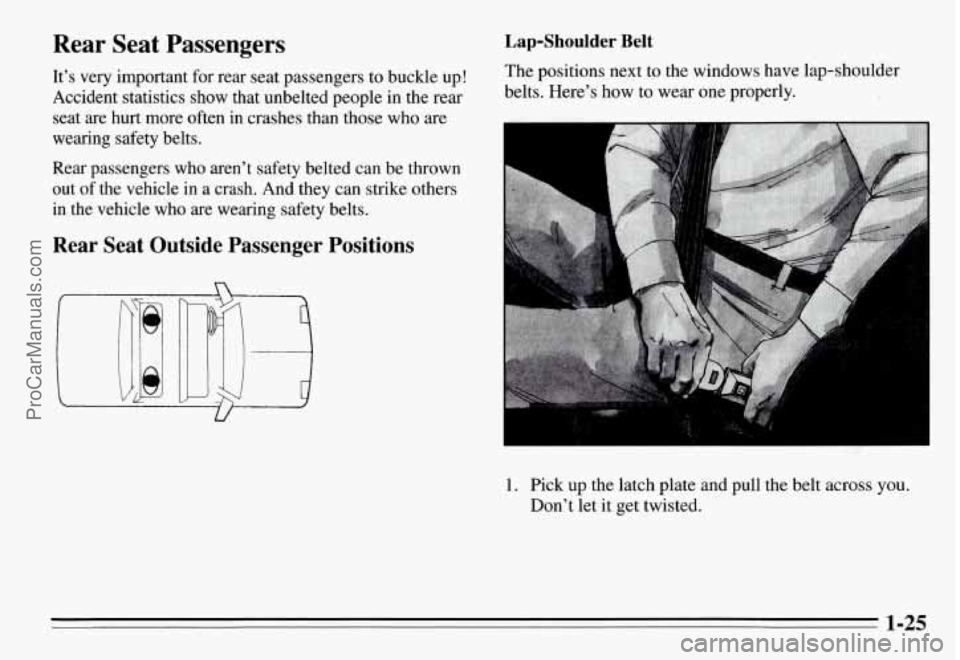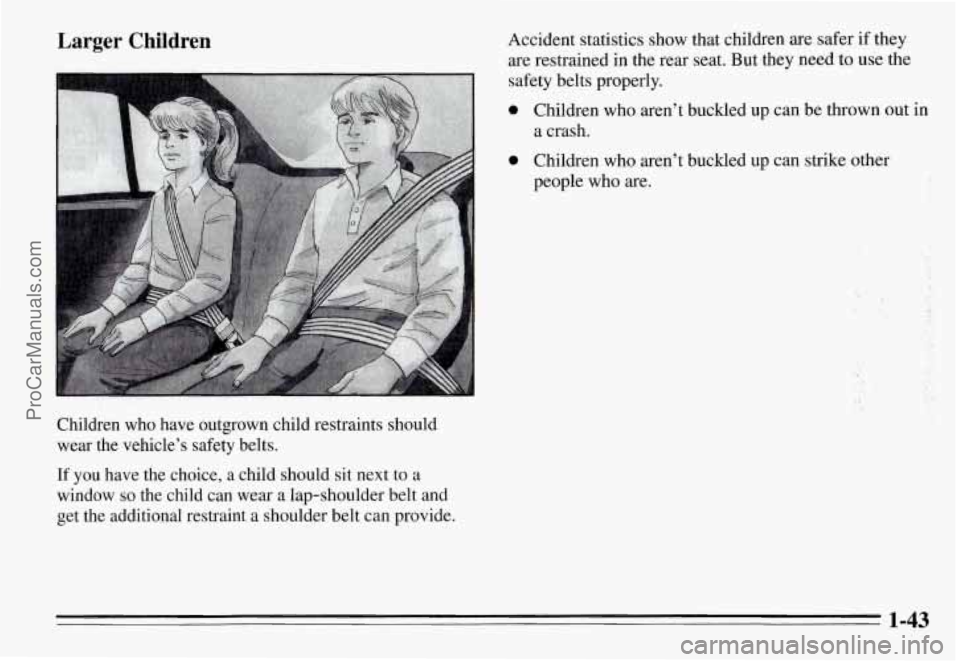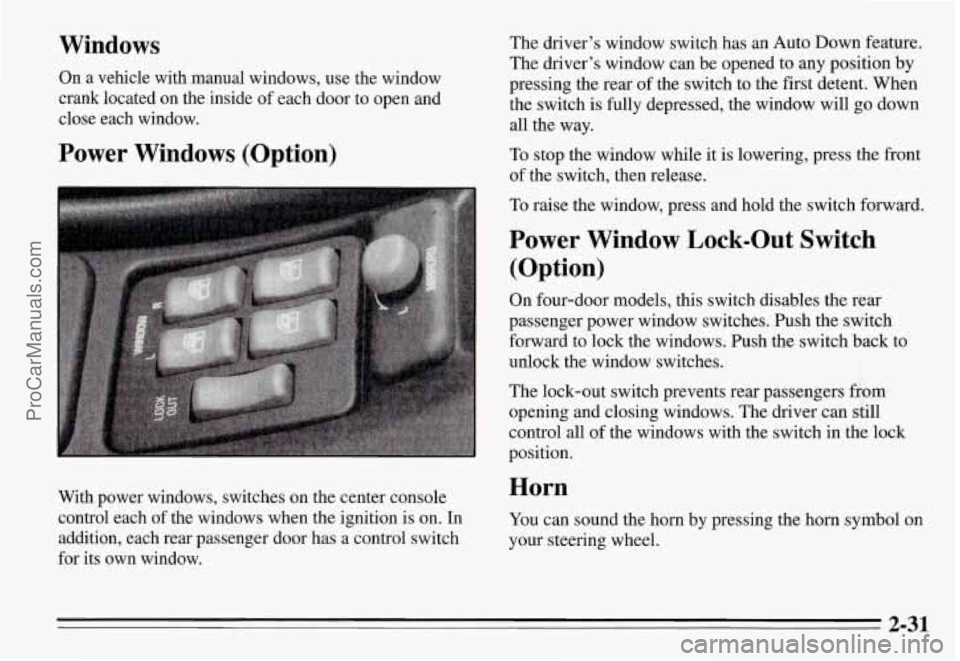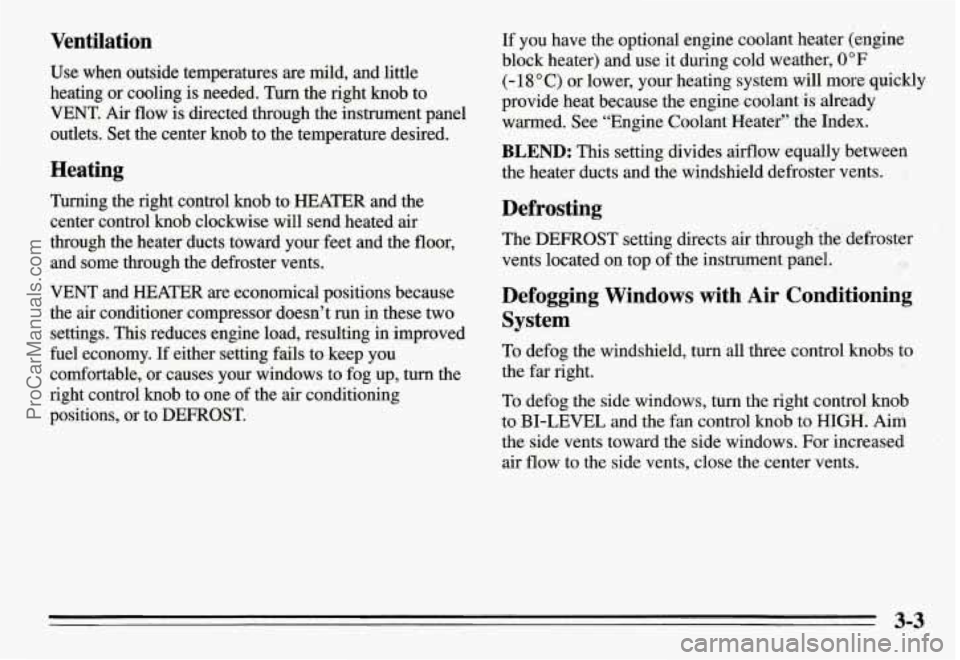1995 PONTIAC GRAND-AM window
[x] Cancel search: windowPage 6 of 354

Vehicle Symbols
These are some of the symbols you may find on your vehicle.
For example,
these symbols
are used on an
original battery:
POSSIBLE A
CAUTION
INJURY
PROTECT EYES BY
SHIELDING
CAUSTIC
BURNS
SPARK OR ,\I/,
COULD FLAME
EXPLODE BATTERY
These symbols are important
for you and
your passengers
whenever your
vehicle
is
driven:
DOOR LOCK
UNLOCK
FASTEN SEAT 4
BELTS
POWER
WINDOW
These symbols
have to do with
your lights:
SIGNALS e 9
TURN
WARNING A
HAZARD
FLASHER
FOG LAMPS $0
These symbols
are on some
of
your controls:
WINDSHIELD
WIPER
WINDSHIELD
DEFROSTER
WINDOW
DEFOGGER
VENTILATING FAN
These symbols are used on
warning and
indicator lights:
COOLANT Fe
TEMP --
ENGINE
CHARGING I-1
BATTERY
SYSTEM
BRAKE (a)
RADIATOR COOLANT
FUEL
ENGINE OIL
PRESSURE
Wb
TEMP OIL &
ANTI-LOCK (@)
BRAKE
Here are some
other symbols
you may see:
FUSE
RELEASE
RADIO
VOLUME
CONDITIONING A‘R 43
RELEASE
LIGHTER m
HORN )tr
SPEAKER
b
V
ProCarManuals.com
Page 32 of 354

Rear Seat Passengers
It’s very important for rear seat passengers to buckle up!
Accident statistics show that unbelted people in the rear seat are hurt more often in crashes than those who
are
wearing safety belts.
Rear passengers who aren’t safety belted can be thrown
out of the vehicle in a crash. And they can strike others
in the vehicle who are wearing safety belts.
Rear Seat Outside Passenger Positions
Lap-Shoulder Belt
The positions next to the windows have lap-shoulder
belts. Here’s
how to wear one properly.
1. Pick up the latch plate and pull the belt across you.
Don’t let it get twisted.
1-25
ProCarManuals.com
Page 50 of 354

Larger Children
." ..... .". .. .
Children who have outgrown child restraints should
wear the vehicle's safety belts.
If you have the choice, a child should sit next to a
window
so the child can wear a lap-shoulder belt and
get the additional restraint a shoulder belt can provide.
Accident statistics show that children are safer if they
are restrained in the rear seat. But they need to use the
safety belts properly.
0 Children who aren't buckled up can be thrown out in
a crash.
0 Children who aren't buckled up can strike other
people who are.
1-43
ProCarManuals.com
Page 65 of 354

Glove Box
P’ !
, :.. 3-
Use one of the vehicle’s keys to lock and unlock the
glove box.
To open, pull the glove box handle toward
you.
Theft
Vehicle theft is big business, especially in some cities.
Although your Pontiac has a number
of theft deterrent
features, we know that nothing we put on it can make
it
impossible to steal. However, there are ways you can
help.
Key in the Ignition
If you walk away from your vehicle with the keys
inside, it’s an easy target for
joy riders or professional
thieves
-- so don’t do it.
When you park your Pontiac and open the driver’s door,
you’ll hear a chime reminding you to remove your key
from.the ignition and take it with you. Always do this.
Your steering wheel will be locked, and so will your
ignition. If you have an automatic transaxle, taking your
key out also locks your transaxle. And remember to lock
the doors.
Parking at Night
Park in a lighted spot, close all windows and lock your
vehicle. Remember to keep your valuables out
of sight.
Put them in a storage area, or take them with you.
Parking Lots
If you park in a lot where someone will be watching
your vehicle, it’s best to lock
it up and take your keys.
But what
if you have to leave your ignition key? What if
you have to leave something valuable in your vehicle?
Put your valuables in a storage area, like your trunk
or glove box.
Lock the glove box. , I, ’ .- ’;
0 Lock all the doors except the driver’s.
0 Then take the door key with you.
2-10
ProCarManuals.com
Page 86 of 354

Windows
On a vehicle with manual windows, use the window
crank located on the inside of each door to open and
close each window.
Power Windows (Option)
With power windows, switches on the center console
control each of the windows when the ignition
is on. In
addition, each rear passenger door has a control switch
for its own window.
The driver’s window switch has an Auto Down feature.
The driver’s window can be opened to any position by
pressing the rear
of the switch to the first detent. When
the switch is fully depressed, the window will go down
all the way.
To stop the window while it is lowering, press the front
of the switch, then release.
To raise the window, press and hold the switch forward.
Power Window Lock-Out Switch
(Option)
On four-door models, this switch disables the rear
passenger power window switches. Push the switch
forward to lock the windows. Push the switch back to
unlock the window switches.
The lock-out switch prevents rear passengers from
opening and closing windows. The driver can
dill
control all of the windows with the switch in the lock
position.
Horn
You can sound the horn by pressing the horn symbol on
your steering wheel.
2-31
ProCarManuals.com
Page 108 of 354

i
The main components of your instrument panel are:
1. Fog Lamp Switch
2. Instrument Panel Intensity Control/ Interior Lamps
Switch
3. Side Vent
4. Turn SignaVMultifunction Lever
5. Hazard Warning Flashers Switch
6. Instrument Cluster
7. Windshield WipersNasher Stalk
8. Center Vent
9. Audio System
10. Side Vent
11. Side Window Defogger Vent
12. Glove Box
13. Climate Control System
14. AshtrayLighter
15. Gear Shift Lever
16. Rear Window Defogger (Option)
17. Ignition Switch
18. SRS - Supplemental Restraint System (Air Bag)
19. Horns
20. Tilt Steering Wheel Lever (Option)
21. Parking Brake Release Lever
22. Hood Release Handle
23. Fuse Panel
2-53
ProCarManuals.com
Page 125 of 354

VENT Use when outside temperatures are mild,
and little heating or cooling is needed. Air flow is
through the instrument panel outlets. Set the center
control knob to the temperature desired.
HEATER: This setting brings heated air through
the heater ducts, and some through the windshield
defroster vents.
If you have the optional engine coolant heater (engine
block heater) and use it during cold weather,
0°F
(- 18 “C) or lower, your heating system will more quickly
provide heat because the engine coolant is already
warmed. See “Engine Coolant Heater” in the Index.
9 BLEND: This setting divides air flow equally
between the heater ducts and the windshield defroster
vents.
DEFROST This setting directs air through the
windshield defroster vents located on top of the
instrument panel.
Defogging Windows
To defog the windshield, turn all three control knobs to
the
far right.
Air Conditioning System (Option)
The air conditioner and heater work best if you keep
your windows closed while using them. Your vehicle
also has the flow-through ventilation system described
later in this section.
Air Conditioning
Your system has three air conditioner settings. Before using
your
air conditioner on very hot days, open the windows
long enough to let hot inside
air escape. This reduces the
amount
of work your air conditioner’s compressor will have
to do, which should help fuel economy.
MAX: Use for maximum cooling. This setting
recirculates much of the air inside your vehicle
so it
maximizes your air conditioner’s performance and your
vehicle’s fuel economy.
A/C: Use for normal cooling on hot days. This setting
cools outside air and directs it through the instrument
panel outlets.
BI-LEVEL: Use on cool, but sunny days. This
setting brings in the outside air, but directs it in two
ways. The cool air is directed to the upper portion
of
your body through the instrument panel outlets, but
slightly warmer air is directed through the heater ducts
and defroster vents. At times this temperature difference
may be more apparent than others.
ProCarManuals.com
Page 126 of 354

Ventilation
Use when outside temperatures are mild, and little
heating or cooling is needed.
Turn the right knob to
VENT. Air
flow is directed through the instrument panel
outlets. Set the center knob to the temperature desired.
Heating
Turning the right control knob to HEATER and the
center control knob clockwise will send heated air
through the heater ducts toward your feet and the
floor,
and some through the defroster vents.
VENT and HEATER are economical positions because
the air conditioner compressor doesn’t run in these two
settings. This reduces engine load, resulting in improved
fuel economy. If either setting fails to keep you
comfortable, or causes your windows to fog up, turn the
right control
knob to one of the air conditioning
positions, or to DEFROST.
If you have the optional engine coolant heater (engine
block heater) and use it during cold weather,
0°F
(- 18 O C) or lower, your heating system will more quickly
provide heat because the engine coolant ‘is already
warmed. See “Engine Coolant Heater” the Index.
BLEND: This setting divides airflow equally between
the heater ducts and the windshield defroster vents.
Defrosting
The DEFROST setting directs air through ‘the defroster
vents located on top of the instrument panel.
Defogging Windows with Air Conditioning
System
To defog the windshield, turn all three control knobs to
the far right.
To defog the side windows, turn the right control knob
to BI-LEVEL and the fan control
knob to HIGH. Aim
the side vents toward the side windows. For increased
air flow to the side vents, close the center vents.
22
ProCarManuals.com